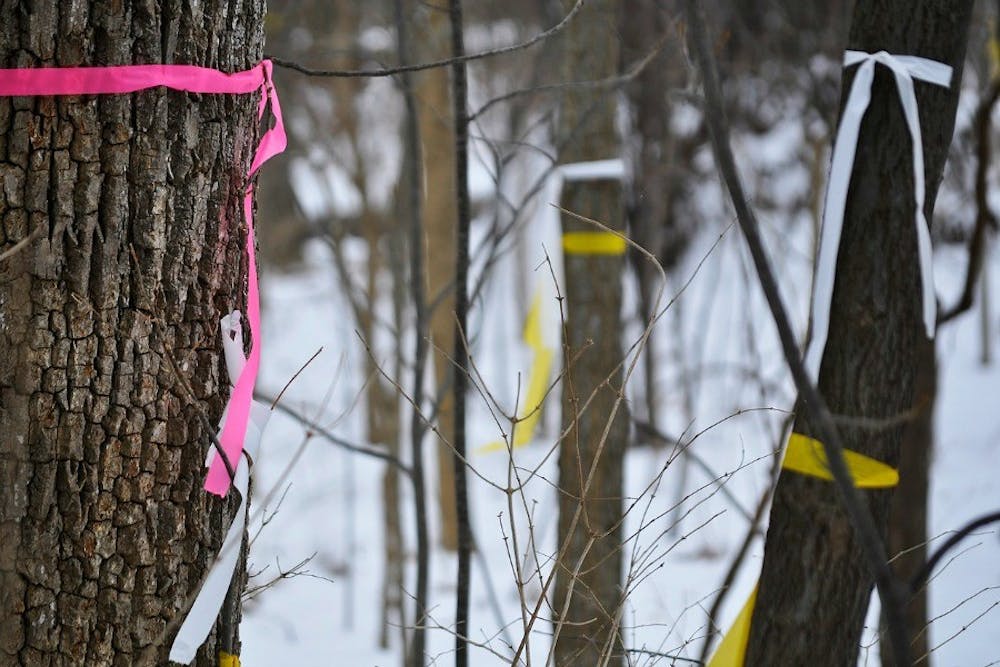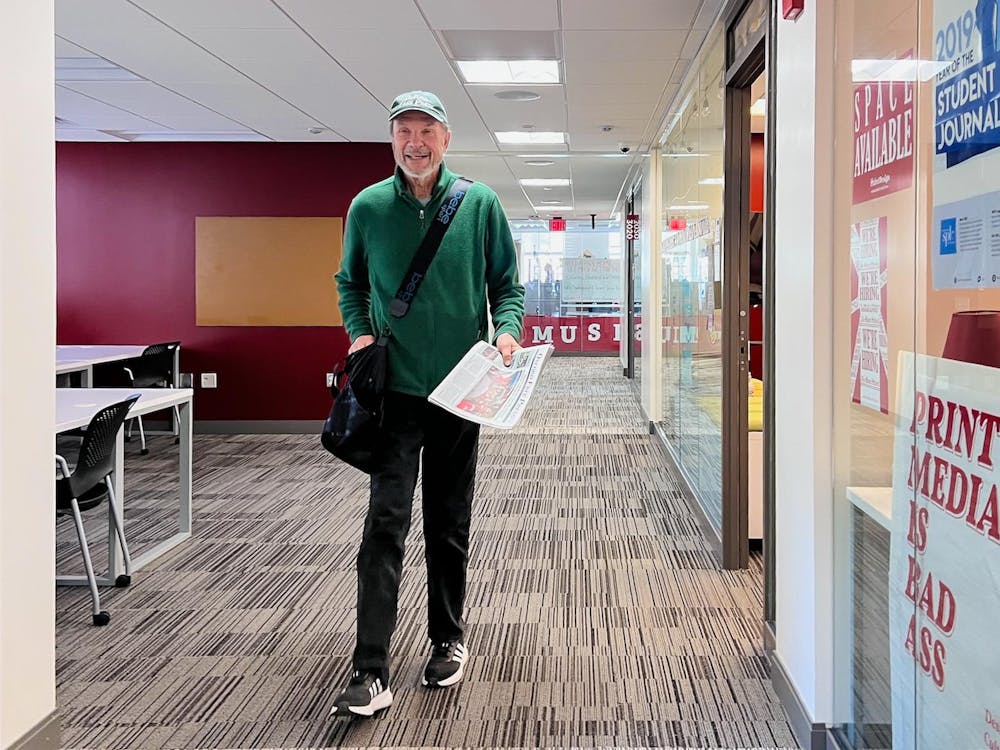Photo by Kim Parent
By Bonnie Meibers, For The Miami Student
Plans to restore and partially open up Bishop Woods are underway.
The white, pink and yellow tape that Miami students see in Bishop Woods is a way of mapping the trees and identifying the diameters.
"It's sort of like an inventory," David Gorchov, a biology professor at Miami University, said.
This inventory is a beginning stage of the plans to restore Bishop Woods. Tentative plans were originally proposed May 2014. On Feb. 11, in a Natural Areas Committee meeting, landscape architect for the university, Vincent Cirrito, proposed a more detailed plan.
Cirrito has plans to remove invasive plants and dead or dying trees, reroute and widen pathways, install LED lights lining the pathways and add a grassy lawn in the center of the wooded area for student congregation.
"There are many features I'm enthusiastic about and there are certain aspects that I have concerns about," Gorchov said.
The Natural Areas Committee, made up mostly of Miami University biology and botany professors and some community members, has some concerns about this plan.
"My major concern about the project is that the large area of grass that would be created puts an unnatural environment in the center of a little island of natural environment," Gorchov said.Gorchov isn't the only committee member with concerns.
"When Miami's botanists have concerns, I have concerns," Holly Wissing, another Natural Areas Committee member, said.
In 1986, the university stopped mowing the lawns in Bishop Woods. The reason for this is disputed. Some say the cost of mowing the lawns was becoming a financial burden and was dropped for that reason; others say mowing was ceased because it was harmful to the trees. Those who share Gorchov's concerns about the lawn are worried about the mowing of the proposed lawn. The maintenance of the lawn, which would require pesticides to be put on it, is also a concern. Pesticides are worrisome because they threaten vegetation and wildlife already living in Bishop Woods.
Enjoy what you're reading?
Signup for our newsletter
"I find the lawn area very important," Cirrito said.
Cirrito wants Bishop Woods to be a place where students can picnic and come together. He wants students to take ownership of Bishop Woods because it is such an important part of Miami's history and heritage. Without this feature, he said, that wouldn't be possible.
A second concern is that the paths are proposed to be eight feet wide. In the plan, the paths are also lined with grass. Gorchov and his supporters fear that this will detract from walking through Bishop Woods, making it more like a park than a wood.
"The widened sidewalks are something I won't back down on," Cirrito said.
He said he thinks the widened pathways are necessary because he is worried that students who walk on the path will try to pass other students or walk next to their friends and in the process trample native plants near the walkway.
LED lights, which will dim to 50 percent when no one is in Bishop Woods, will line the sidewalks. The widened and lit pathways would also grant safety, he says, as students could then see who is in front and around them.
The sidewalks that Cirrito plans to install will "float" above tree roots so that they are not damaged.
Construction gates are going to go up around Bishop Woods the week before Spring Break. The paths should be open to walk on sometime in the summer and then in October seeding and planting of new native plants will take place. This planting will introduce new native species to Bishop Woods.
"Trees of Miami, beautiful trees./Truth, remembrance, youth-/Of these you brood/In your ancient reveries," Percy MacKaye, Miami's first and only poet in residence, said in the 1920s.
MacKaye lived in the middle of what is now Bishop Woods in an isolated shack, to which he would occasionally invite students to poetry readings in the evenings.
"Bishop Woods is different from the rest of Miami's manicured lawns, it is the last remnant of what old Miami was," Wissing said.
Bishop Woods is named after Miami University's first president, Robert Bishop. Bishop Woods was part of a larger forest originally called College Grove and later Lower Campus. As Miami grew, new academic buildings were built, Upham Hall in 1949, Culler Hall in 1961, Shidler Hall in 1967 and Hughes Laboratories in 1970, and the forest was diminished to less than three acres.
The Natural Areas Committee, Cirrito and many others all agree that Bishop Woods is an important piece of Miami history and want it to remain a special place on campus.




